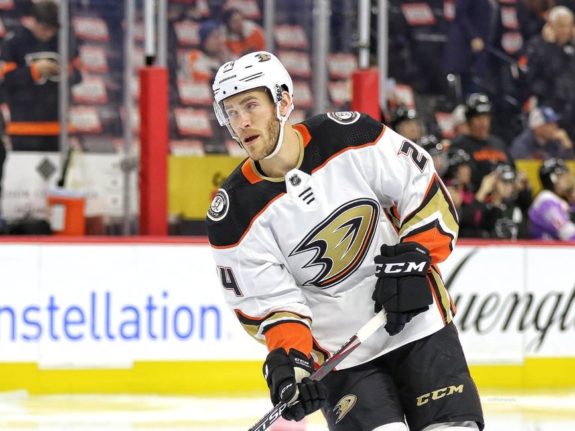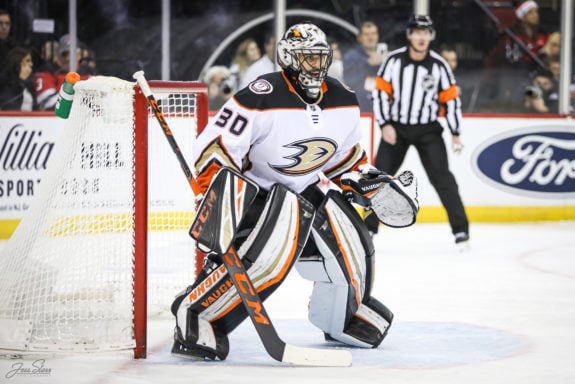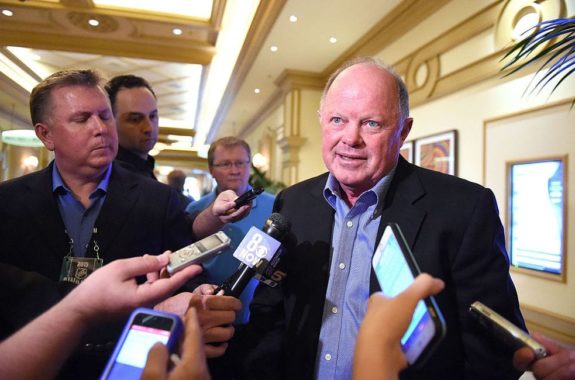Anaheim Ducks fans can’t be blamed for skipping their fill of watching their team on television nowadays. The effort just hasn’t been there as of late for the Southern California team as they dropped yet another series, this time to the San Jose Sharks.
Penalty Panic
There has been much discussion about the Ducks’ special teams this season, mostly about how poor their power play has been. However, the Ducks had been able to offset that with their sparkling performances on the penalty kill. This has changed within the last week as the Ducks have allowed 8 power-play goals in 14 power-play opportunities. After being a top-10 penalty-killing unit for most of the season, they now sit in the bottom-10 in the league. The Ducks haven’t won many games lately, but taking ill-advised penalties and then conceding a goal on the subsequent man advantage isn’t exactly contributing to the cause.

Penalty killing is just one aspect that has caused the Ducks problems during their recent rough spell. The unit hasn’t performed well ever since penalty-kill specialist Carter Rowney suffered a lower-body injury last month. Yesterday it was announced that he would be out for the remainder of the season after undergoing surgery. The power play doesn’t look like it will improve any time soon––and hasn’t for a number of seasons now––which means that improving the penalty kill is essential to evening out their special teams.
Help Out the Goaltender
John Gibson has played a lot this season, perhaps even too much. The 27-year-old has played 1,312 minutes so far this season, which leads the league in minutes played for a goaltender. That total is ahead of No. 2 on the list, Phillip Grubauer, who has played 1,260 minutes. It’s not only a concern that Gibson has played this much during a shortened season (he is almost halfway to his minutes total from the 2019-20 season), but his numbers have declined ever since the 2017-18 season, when the Ducks last made a playoff appearance.
Of course, a lot of that has to do with the composition of the roster as well in recent seasons. There’s a reason that the Ducks haven’t made the playoffs since then. Gibson has been able to bail out the Ducks plenty of times during his career, but he can only do so much before the dam breaks. It’s true, Gibson has already equaled his shutouts total from the previous two seasons during the 2020-21 season, but he also sports a Goals Saved Above Average (GSAA) of minus-8.1. His Really Bad Starts (RBS) total (starts with a save percentage below .850) is already at six after accumulating 10 last season. This also projects to be Gibson’s worst statistical season since he became a full-time starter in the NHL.
Veteran backstop Ryan Miller has been a serviceable backup for the Pittsburgh native. He may be 40 years of age, but he still has exceptional athleticism and positioning. He also should probably be playing more given the state of the team and the need to keep Gibson fresh with so many games being played in such a short span of time.

The Ducks need to help out their goalies more and that starts with keeping pucks out of their own net. They haven’t been as good at that as they need to be but at least you can still win the game if you score more than the opposition. Just ask the Edmonton Oilers. The Ducks are dead last in the league in goals per game and allow the ninth-most goals per game in the league. Their goal differential is minus-32.
Time to Pull the Plug?
With their loss on Saturday night, the Ducks have now lost 12 of their last 15 games. Prior to the beginning of this season, general manager Bob Murray made it clear that he believes this team has the ability to be a playoff contender. It’s quite clear by this point of the season that this is not the case.
Under normal circumstances, you might expect Murray to start selling off some of the team’s assets in exchange for draft capital and prepare for next season. However, COVID-19 has thrown a wrench into trade talks as any player acquired has to undergo a quarantine period, unless they plan on driving themselves to meet up with their new team. Acquisitions involving a Canadian team are even more difficult as any player moving across the border is subject to a 14-day quarantine period. Two weeks can make or break a team’s season and most teams cannot afford to go that long without influential players in the lineup.

The Ducks will have some difficult decisions to make if they decide to go the route of a rebuild. They have a franchise goaltender in Gibson locked down to a long-term deal with plenty of value. Unless they were to receive a goalie, it wouldn’t make sense to trade Gibson just yet as there are no NHL-ready goaltenders in their pipeline.
Ryan Getzlaf’s contract also expires this offseason and while there’s no reason to expect that the veteran will be going anywhere, he may be eying one last chance at winning another Cup. Murray has made it clear that Getzlaf will not be traded unless the captain personally asks to be dealt. (from, ‘Ducks GM Bob Murray on trades: ‘Talking and listening about lots of things’’, The Athletic, 03/08/21) Dealing the captain to a Cup contender and then bringing him back in the offseason would be a move that makes sense for both parties.
Reverse Retro in Colorado
The Ducks now embark on a one-game road trip to Denver where they will debut their Reverse Retro jerseys against the Colorado Avalanche. The Avalanche have won four of their last six games and play on Sunday against the Los Angeles Kings. Mikko Rantanen has performed well this season and is filling the offensive void left by Cale Makar, who is currently on injured reserve. Along with Makar, Conor Timmins, Bowen Byram, Erik Johnson and Dennis Gilbert are also out due to injury, which means that the Avalanche will have a relatively shallow blue line.